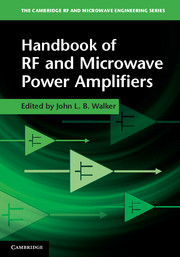Book contents
- Frontmatter
- Contents
- Contributors
- Preface
- 1 Silicon LDMOS and VDMOS transistors
- 2 GaAs FETs – physics, design, and models
- 3 Wide band gap transistors – SiC and GaN – physics, design and models
- 4 Amplifier classes, A to S
- 5 Computer-aided design of power amplifiers
- 6 Practical HF/VHF/UHF RF power amplifier realization
- 7 Microwave hybrid amplifier realization
- 8 Monolithic power amplifiers
- 9 RF power amplifier thermal design
- 10 Reliability
- 11 Power amplifier applications
- 12 Amplifier measurements
- About the authors
- Index
- References
9 - RF power amplifier thermal design
Published online by Cambridge University Press: 05 November 2011
- Frontmatter
- Contents
- Contributors
- Preface
- 1 Silicon LDMOS and VDMOS transistors
- 2 GaAs FETs – physics, design, and models
- 3 Wide band gap transistors – SiC and GaN – physics, design and models
- 4 Amplifier classes, A to S
- 5 Computer-aided design of power amplifiers
- 6 Practical HF/VHF/UHF RF power amplifier realization
- 7 Microwave hybrid amplifier realization
- 8 Monolithic power amplifiers
- 9 RF power amplifier thermal design
- 10 Reliability
- 11 Power amplifier applications
- 12 Amplifier measurements
- About the authors
- Index
- References
Summary
Why thermal design deserves careful attention?
A very large fraction of the energy consumed by the radio base station (RBS) of wireless infrastructure equipment ends up as waste heat. Power amplifiers consume the largest share of the energy used by the radio base station. From a system perspective, the efficiency of energy conversion (from drawn DC power to launched RF output power) in an RBS is very low, of the order of 1.2% [1]. Similar concerns prevail for radio/TV broadcast equipment and radar equipment. Thus, improving the efficiency of power conversion (DC to RF) and low-loss launching of the RF power are major drives in the industry. Even with such an on-going drive, efficient removal and disposal of the waste heat are vitally important to keep the temperature of the power amplifiers in control. Removal and disposal of this waste heat adds to the capital and operating expenditures for wireless infrastructure equipment makers and network providers who operate such equipment. In this chapter we will examine how thermal design and temperature control influence the cost, device electrical performance and reliability of RFPAs.
Thermal management adds substantial cost to the reliable operation of an RBS. From the construction of an RFPA component, to managing various thermal interfaces, to the added heatsinks to reduce the heat flux, and to the ultimate disposal of the waste heat with the help of cooling equipment, many special materials, special manufacturing processes, and physical hardware are utilized, adding substantial cost to an RBS. Later sections will address in more detail such specialty materials, manufacturing and assembly processes and cooling hardware. Given the fact that waste heat removal and its disposal are a necessity, good thermal management practices in the construction and operation of an RFPA can potentially help reduce both the initial equipment cost and subsequent operational cost.
- Type
- Chapter
- Information
- Handbook of RF and Microwave Power Amplifiers , pp. 411 - 445Publisher: Cambridge University PressPrint publication year: 2011



